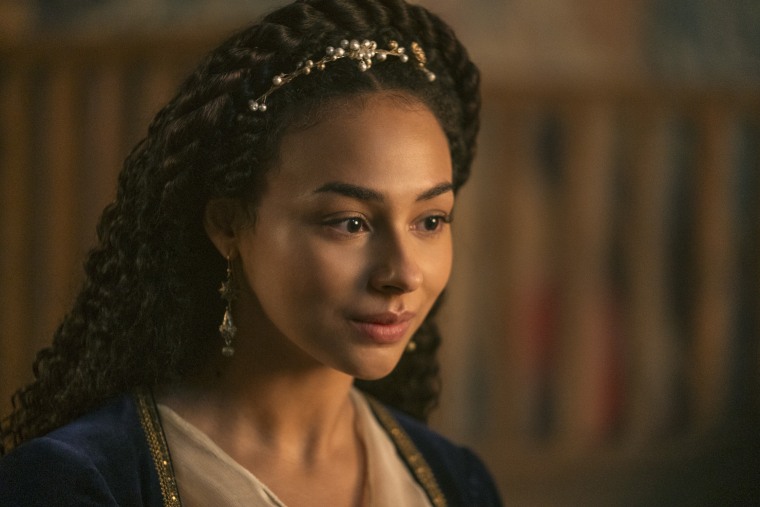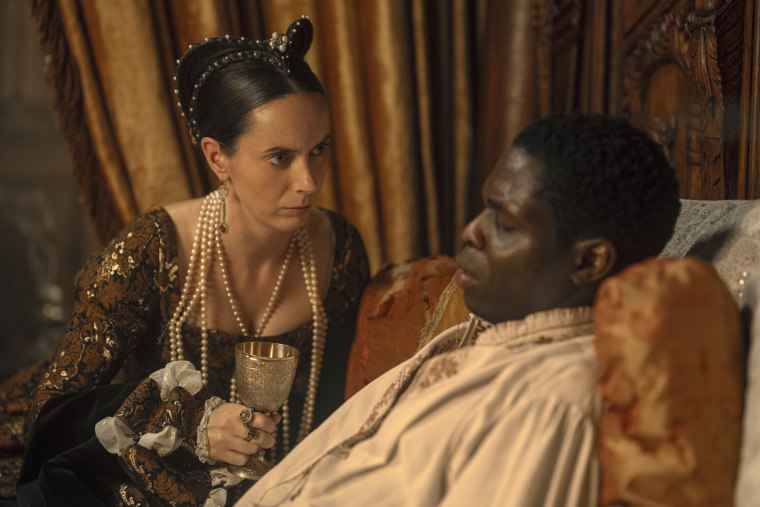‘My Lady Jane’ puts a fantasy spin on the life of a Tudor monarch. The true story of the ‘Nine-Day Queen’

[ad_1]
Prime Video’s latest release is putting a modern spin on the tragic true story of Lady Jane Grey, who holds the title for the shortest reign in British history.
Jane Grey was queen for just nine days, from July 10, 1553, to July 19, 1553, leaving her with the apt nickname the “Nine-Day Queen.” Her tumultuous short reign and her reported love for learning are reimagined in “My Lady Jane.” Instead of a reluctant 17-year-old queen, Jane (played by Emily Bader) is a wise-cracking teen who dreams of writing her own book.
A voice-over at the start of the eight-episode show calls Jane an “intellectual rebel, a bit of a pain in the ass and a political pawn for her ambitious noble family.”
“Jane could have been the leader England needed. But instead, history remembers her as the ultimate damsel in distress,” the show’s narrator, Oliver Chris, says. “F— that.”

Like the pop musical “Six” and the beloved romantic drama “Bridgerton,” “My Lady Jane” puts a modern twist on British history through its soundtrack, feminist themes and anachronistic language.
But the Prime Video show, which hit the streaming platform June 27, adds a new element: magic, specifically in the form of shape-shifters.
Read on for everything to know about the inspirations for “My Lady Jane” — including the true story of Lady Jane Grey.
What happened to Lady Jane Grey?
Lady Jane Grey was born in 1537, one of the great-nieces of Henry VIII, the king of England known for having six wives.
She’s remembered as a strong student who studied classical languages and was exposed to Protestantism, the branch of Christianity that Henry VIII turned England towards when he founded the Church of England (more on this later).

According to Historic Royal Palaces, an organization founded by the United Kingdom for the preservation of the country’s palaces, Jane was almost set up to marry her cousin, King Edward VI, by her foster father Thomas Seymour, the brother of Henry VIII’s third wife, Jane Seymour.
Edward VI was just 9 years old when he took the throne after his father Henry VIII’s death, leading to attempts to exploit the young child’s favor. But after Thomas Seymour tried to break into the king’s room, he was executed, and Jane sent home.
In January 1553, Edward VI got sick, and the 15-year-old started to think about his succession. Edward VI wanted a male Protestant to take the throne, so he disinherited his half-sisters: Mary (also known as “Bloody Mary”), the daughter of Henry VIII and Catherine of Aragon, and Elizabeth, daughter of Anne Boleyn.
Meanwhile, a new political leader emerged — John Dudley, later the Earl of Northumberland. Dudley masterminded a marriage between Jane, then 16, and his son, Guildford Dudley, then 18, in May 1553.
When Edward VI’s illness turned fatal just weeks later, in June 1553, he officially named Lady Jane Grey — and her hopefully male heirs — the future monarchs.
The king died on July 6, and Jane inherited the crown on July 9, 1553. But the 17-year-old didn’t want the throne and refused to wear the crown.
Mary soon sought revenge by using her Catholic supporters to raise an army and demand she be named queen as the eldest daughter of Henry VIII. The country rallied around Mary, according to the royal family’s official website, and Jane was deposed on July 19, 1553.
Jane and Guildford were imprisoned in the Tower of London, through Mary originally intended to let her young cousin live, according to the Historic Royal Palaces website. But in 1554, Protestant uprisings against Mary’s Catholic policies and plans made Jane a threat to her crown.
Mary offered to let Jane and Guildford live if they converted to Catholicism, but they refused and were sentenced to death.
Jane died Feb. 12, 1554.
Mary died in 1558, and the crown went to her sister Elizabeth, who settled some of the religious tension with a compromise known as the Elizabethan Settlement. The legislation established an independent Church of England with some of the ceremony and ritual that appealed to Catholics.
Her nearly 50-year reign, known as the Elizabethan era, is today remembered by some as a golden age, with England defeating the Spanish Armada in 1588 and William Shakespeare writing “Romeo and Juliet” in the 1590s.
What is ‘My Lady Jane’ based on?
“My Lady Jane” is based on the 2016 young adult fantasy novel written by Cynthia Hand, Brodi Ashton and Jodi Meadows. Like the show, the book’s synopsis clearly separates itself from reality: “My Lady Jane” bears “only a passing resemblance to actual history—because sometimes history needs a little help,” it states.
In both the book and show, England’s religious conflict is replaced by a more simplistic division: shape-shifter or human.
In the world of “My Lady Jane,” the world is made up of Ethians, or people who can turn into a specific animal form, or Verities, who are essentially normal humans. Different rulers have different levels of tolerance for Ethians, similar to monarch’s different allegiances to Protestantism or Catholicism during the English Reformation.

For example, Anne Boleyn, the mother of Elizabeth (played by Abbie Hern), is said to have been an Ethian, suggesting Henry VIII had tolerance for the group.
But Elizabeth’s half-sister Mary (Kate O’Flynn) calls Ethians “Satan’s beasts” in the first episode.

In addition to its fantastical elements, “My Lady Jane” is also a romance, with the primary love story being between Jane (Emily Bader) and her real-life husband, Guildford (Edward Bluemel).

“My Lady Jane” is the first in the series of three books, called “The Lady Janies.” Books two and three follow Jane Eyre and Calamity Jane, respectively.



